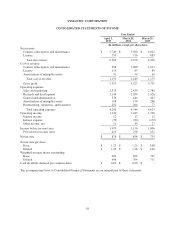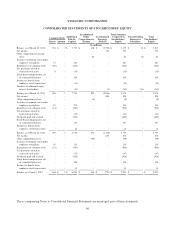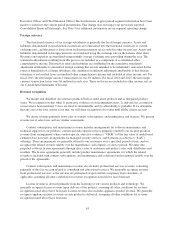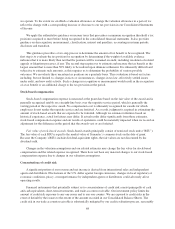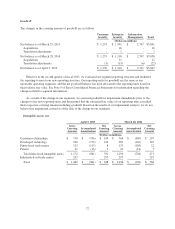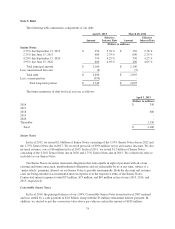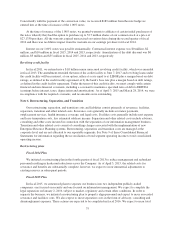Symantec 2015 Annual Report Download - page 146
Download and view the complete annual report
Please find page 146 of the 2015 Symantec annual report below. You can navigate through the pages in the report by either clicking on the pages listed below, or by using the keyword search tool below to find specific information within the annual report.we operate. To the extent we establish a valuation allowance or change the valuation allowance in a period, we
reflect the change with a corresponding increase or decrease to our tax provision in our Consolidated Statements
of Income.
We apply the authoritative guidance on income taxes that prescribes a minimum recognition threshold a tax
position is required to meet before being recognized in the consolidated financial statements. It also provides
guidance on derecognition, measurement, classification, interest and penalties, accounting in interim periods,
disclosure and transition.
This guidance prescribes a two-step process to determine the amount of tax benefit to be recognized. The
first step is to evaluate the tax position for recognition by determining if the weight of available evidence
indicates that it is more likely than not that the position will be sustained on audit, including resolution of related
appeals or litigation processes, if any. The second step requires us to estimate and measure the tax benefit as the
largest amount that is more than 50% likely to be realized upon ultimate settlement. It is inherently difficult and
subjective to estimate such amounts, as this requires us to determine the probability of various possible
outcomes. We reevaluate these uncertain tax positions on a quarterly basis. This evaluation is based on factors
including, but not limited to, changes in facts or circumstances, changes in tax law, effectively settled issues
under audit, and new audit activity. Such a change in recognition or measurement would result in the recognition
of a tax benefit or an additional charge to the tax provision in the period.
Stock-based compensation
Stock-based compensation expense is measured at the grant date based on the fair value of the award and is
generally recognized ratably on a straight-line basis over the requisite service period, which is generally the
vesting period of the respective award. No compensation cost is ultimately recognized for awards for which
employees do not render the requisite service and are forfeited. As a result, judgment is required in estimating the
amount of stock-based awards that are expected to be forfeited. Although we estimate forfeitures based on
historical experience, actual forfeitures may differ. If actual results differ significantly from these estimates,
stock-based compensation expense and our results of operations could be materially impacted when we record an
adjustment for the difference in the period that the awards vest or are forfeited.
Fair value of stock-based awards. Stock-based awards principally consist of restricted stock units (“RSU”).
The fair value of each RSU is equal to the market value of Symantec’s common stock on the date of grant.
Because the Company’s RSUs include dividend-equivalent rights, the fair values are not discounted by the
dividend yield.
Changes in the valuation assumptions and our related estimates may change the fair value for stock-based
compensation and the related expense recognized. There have not been any material changes to our stock-based
compensation expense due to changes in our valuation assumptions.
Concentrations of credit risk
A significant portion of our revenue and net income is derived from international sales and independent
agents and distributors. Fluctuations of the U.S. dollar against foreign currencies, changes in local regulatory or
economic conditions, piracy, or nonperformance by independent agents or distributors could adversely affect
operating results.
Financial instruments that potentially subject us to concentrations of credit risk consist principally of cash
and cash equivalents, short-term investments, and trade accounts receivable. Our investment policy limits the
amount of credit risk exposure to any one issuer and to any one country. We are exposed to credit risks in the
event of default by the issuers to the extent of the amount recorded in our Consolidated Balance Sheets. The
credit risk in our trade accounts receivable is substantially mitigated by our credit evaluation process, reasonably
68


